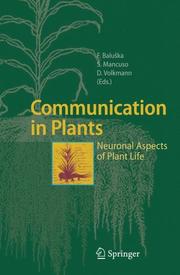| Listing 1 - 2 of 2 |
Sort by
|

ISBN: 9783540285168 9783540284758 3540284753 3642066720 9786610608720 1280608722 3540285164 Year: 2006 Publisher: Berlin, Heidelberg : Springer Berlin Heidelberg : Imprint: Springer,
Abstract | Keywords | Export | Availability | Bookmark
 Loading...
Loading...Choose an application
- Reference Manager
- EndNote
- RefWorks (Direct export to RefWorks)
Plant neurobiology is a newly emerging field of plant sciences. It covers signalling and communication at all levels of biological organization – from molecules up to ecological communities. In this book, plants are presented as intelligent and social organisms with complex forms of communication and information processing. Authors from diverse backgrounds such as molecular and cellular biology, electrophysiology, as well as ecology treat the most important aspects of plant communication, including the plant immune system, abilities of plants to recognize self, signal transduction, receptors, plant neurotransmitters and plant neurophysiology. Further, plants are able to recognize the identity of herbivores and organize the defence responses accordingly. The similarities in animal and plant neuronal/immune systems are discussed too. All these hidden aspects of plant life and behaviour will stimulate further intense investigations in order to understand the communicative plants in their whole complexity.
Histologie. Cytologie --- Fysiologie en biofysica der planten --- Neurofysiologie. Zintuigfysiologie --- Industriële biochemie --- systematische plantkunde --- biochemie --- cytologie --- histologie --- planten --- neurobiologie --- Plant cellular signal transduction --- Plant physiology --- Plant physiology. --- Cytology. --- Biochemistry. --- Botany. --- Neurobiology. --- Plant Physiology. --- Cell Biology. --- Plant Biochemistry. --- Plant Sciences. --- Neurosciences --- Botany --- Plants --- Physiology --- Botanical science --- Phytobiology --- Phytography --- Phytology --- Plant biology --- Plant science --- Biology --- Natural history --- Biological chemistry --- Chemical composition of organisms --- Organisms --- Physiological chemistry --- Chemistry --- Medical sciences --- Cell biology --- Cellular biology --- Cells --- Cytologists --- Composition --- Cell biology. --- Plant biochemistry. --- Plant science. --- Phytochemistry --- Plant biochemistry --- Plant chemistry --- Biochemistry --- Phytochemicals --- Plant biochemical genetics --- Floristic botany --- Acqui 2006

ISSN: 00796484 ISBN: 9783540691617 9783540691600 354069160X 3642088651 3540691618 Year: 2007 Volume: 45 Publisher: Berlin, Heidelberg : Springer Berlin Heidelberg : Imprint: Springer,
Abstract | Keywords | Export | Availability | Bookmark
 Loading...
Loading...Choose an application
- Reference Manager
- EndNote
- RefWorks (Direct export to RefWorks)
Cell biologists have recently become aware that the asymmetry of cell division is an important regulatory phenomenon in the fate of a cell. During development, cell diversity originates through asymmetry; in the adult organism asymmetric divisions regulate the stem cell reservoir and are a source of the drift that contributes to the aging of organisms with renewable cell compartments. Because of the concept of semi-conservative DNA synthesis, it was thought that the distribution of DNA between daughter cells was symmetric. The analysis of the phenomenon in cells during mitosis, however, revealed the asymmetry in the distribution of the genetic material that creates the drift contributing to aging of mammals. On the other hand, cancer cells can originate from a deregulation of asymmetry during mitosis in particular during stem cell expansion. The book describes the phenomenon in different organisms from plants to animals and addresses its implications for the development of the organism, cell differentiation, human aging and the biology of cancers.
embryologie (geneeskunde) --- histologie --- Histology. Cytology --- Oncology. Neoplasms --- General embryology. Developmental biology --- oncologie --- cytologie --- Cell division --- Cell differentiation --- Genetic recombination --- Symmetry (Biology) --- Biodiversity --- Cellules --- Recombinaison génétique --- Molecular aspects --- Genetic aspects --- Division --- Life Sciences --- Biology --- Molecular biology --- Biologie moléculaire --- Biologie moléculaire --- MDBIOCHE --- Cell differentiation. --- Cell division. --- Developmental biology. --- Cytology. --- Oncology. --- Developmental Biology. --- Cell Biology. --- Cancer Research. --- Tumors --- Cell biology --- Cellular biology --- Cells --- Cytologists --- Development (Biology) --- Growth --- Ontogeny --- Cell biology. --- Cancer research. --- Cancer research
| Listing 1 - 2 of 2 |
Sort by
|

 Search
Search Feedback
Feedback About
About Help
Help News
News